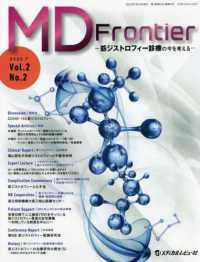- ホーム
- > 洋書
- > 英文書
- > Science / Mathematics
Full Description
Gauss famously referred to mathematics as the "queen of the sciences" and to number theory as the "queen of mathematics". This book is an introduction to algebraic number theory, meaning the study of arithmetic in finite extensions of the rational number field Q.
Originating in the work of Gauss, the foundations of modern algebraic number theory are due to Dirichlet, Dedekind, Kronecker, Kummer, and others. This book lays out basic results, including the three "fundamental theorems": unique factorization of ideals, finiteness of the class number, and Dirichlet's unit theorem. While these theorems are by now quite classical, both the text and the exercises allude frequently to more recent developments.
In addition to traversing the main highways, the book reveals some remarkable vistas by exploring scenic side roads. Several topics appear that are not present in the usual introductory texts. One example is the inclusion of an extensive discussion of the theory of elasticity, which provides a precise way of measuring the failure of unique factorization.
The book is based on the author's notes from a course delivered at the University of Georgia; pains have been taken to preserve the conversational style of the original lectures.
Contents
Getting our feet wet
Cast of characters
Quadratic number fields: First steps
Paradise lost--and found
Euclidean quadratic fields
Ideal theory for quadratic fields
Prime ideals in quadratic number rings
Units in quadratic number rings
A touch of class
Measuring the failure of unique factorization
Euler's prime-producing polynomial and the criterion of Frobenius-Rabinowitsch
Interlude: Lattice points
Back to basics: Starting over with arbitrary number fields
Integral bases: From theory to practice, and back
Ideal theory in general number rings
Finiteness of the class group and the arithmetic of $\overline{\mathbb{Z}}$
Prime decomposition in general number rings
Dirichlet's units theorem, I
A case study: Units in $\mathbb{Z}[\sqrt[3]{2}]$ and the Diophantine equation $X^3-2Y^3=\pm1$
Dirichlet's units theorem, II
More Minkowski magic, with a cameo appearance by Hermite
Dedekind's discriminant theorem
The quadratic Gauss sum
Ideal density in quadratic number fields
Dirichlet's class number formula
Three miraculous appearances of quadratic class numbers
Index.






